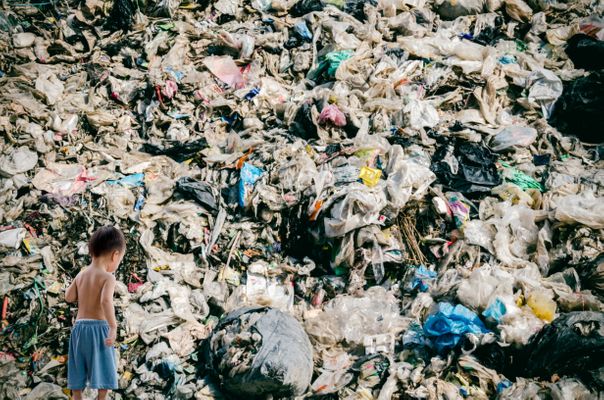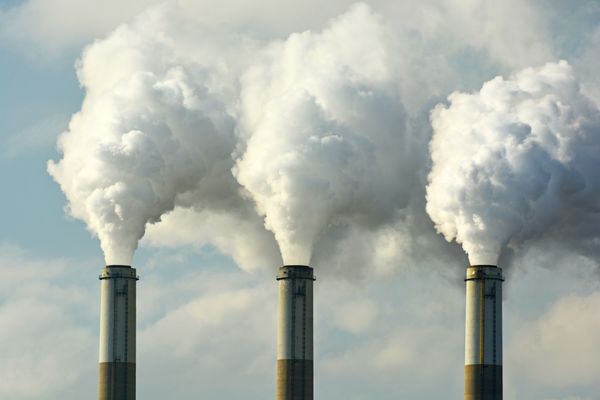9.3.5
Superpowers & the Environment
Superpowers and the Environment
Superpowers and the Environment
With continued development and economic growth, the resource demands of superpowers continue to grow and cause environmental degradation.


Natural resources
Natural resources
- Superpowers' demand for food, fossil fuels and minerals is causing environmental degradation.
- The richest countries in the world consume on average 10 times as many materials as the poorest countries and twice as much as the world average.
- As an emerging country, China's industrialization and urban growth have required unprecedented amounts of iron, steel, cement, energy and construction materials.
- Between 2011 and 2013 China used more cement than the US did in the entire 20th century.


Carbon emissions
Carbon emissions
- Given their high proportion of economic activity and global population, the carbon emissions of superpowers contribute disproportionately to global warming and climate change.
- China is the world’s biggest consumer of energy and most of that energy comes from burning coal mined in China itself.
- China is the top country for fossil fuel extraction.


Plastic waste
Plastic waste
- In a recent study, China topped the global ranking for the country releasing the most plastic into the oceans.
- According to this study, in 2010 8.8 million tons of plastic waste in the ocean could be traced back to China.
- The United States was also in the top 10 but at a much lower level than China. They released 0.3 million tons.
Superpowers and Climate Change
Superpowers and Climate Change
Different nations display different attitudes with regards to climate change and their willingness to act. Arguably the EU and China are leading the way with their willingness to act.


The EU
The EU
- The EU has become a global leader in many climate initiatives.
- It aims to cut its greenhouse gas emissions by 20% by 2020 (compared to 1990 levels).
- It wants 20% of the total energy consumption to come from renewable energy by 2020.


China
China
- China supported the 2015 Paris agreement. This is important as it is the world’s largest emitter and thus must be involved in any deal that is to be a success.
- In 2017, China and the EU set up a new alliance to further tackle climate change. They are determined to ‘lead the energy transition’ toward a low-carbon economy.


The USA
The USA
- At the time of the 2015 Paris agreement, USA ratified the agreement and signed up. It has led the way in reducing its emissions and under President Obama invested heavily in renewable energy.
- However, in 2017, President Trump pulled out of the Paris agreement. He does not agree that climate change is a global threat.
- President Trump has undone many of Obama’s actions that aimed to curb climate change and limit environmental pollution.
- In May 2018, Trump ended the $10 million a year NASA program to monitor carbon dioxide levels in the atmosphere.
- This tool was key to verifying whether or not nations of the world were actually meeting their pledges to reduce carbon emissions.


Russia
Russia
- Russia did support the 2015 Paris agreement. However, most people believe that Russia has not changed its attitude.
- Russia has agreed to reduce CO2 levels by 30% to 1990 levels.
- However, because of the collapse of the USSR, its current emissions are actually still below 1990 levels, when Russia was at the peak of its manufacturing!
- So, having agreed to this, it actually allows Russia to increase its emissions.
- Extreme weather events in Russia have doubled over the past 25 years and Russia's attitude may change because of this.
- Climate-related economic damage is expected to reach $4.3 billion a year by 2025 for the Moscow region.
Impact of the Global Middle Class
Impact of the Global Middle Class
The size of the global middle class is growing. This is having an impact on the demand for key resources, such as rare minerals, oils, meat, grains and water.


Consumption and consumerism
Consumption and consumerism
- Rising consumption fuelled by a growing middle class has seen the number of primary materials extracted from the Earth treble in the last four decades.
- This increase has increased air pollution, reduced biodiversity and sped up climate change.


Meat and water supplies
Meat and water supplies
- The biggest problem in terms of environmental degradation is that the middle class is going to eat more meat than ever before.
- This creates a problem for global water supply as raising cattle and washing and processing meat requires much more water than most crops.
- The growing middle class is concentrated largely in Asia.
- China’s increased affluence saw its meat consumption increase by 99%, its perfume consumption increase by 133% and its cereal consumption increase by 364% between 2000 and 2018.


Grains
Grains
- The global middle class and worldwide population growth will strain grain reserves too.
- In 2017, the prices of wheat, corn, soybeans, and rice are already twice what they were in 2000.
- It can, of course, be argued that the growing middle class might demand climate action more quickly and help towards dealing with climate change.


Precious metals
Precious metals
- Another key idea for the next few decades is that as well as for consumer goods, rare earth metals are also very important for the construction of renewable energy generators.
- Within the next few decades, a new set of naturally occurring elements could become key and therefore different countries will dominate the production of key resources.
- Platinum and Palladium are rare metals that may be needed for use in batteries and electric vehicles.
1Tectonic Processes & Hazards
1.1Tectonic Processes & Hazards
1.2Natural Disasters
1.3Natural Disaster Case Studies
1.4Trends & Patterns
2Option 2A: Glaciated Landscapes & Change
2.1Glaciated Landscapes Over Time
2.2Periglacial Landscapes
2.3Glacial Processes
2.4Glacial Landforms
3Option 2B: Coastal Landscapes & Change
3.1Coastal Landscapes
3.2Coastal Erosion & Deposition
3.3Coastal Risks
4Globalisation
4.1Globalisation
4.2Negatives of Globalisation
4.3Global Shift
4.5Culture
4.6Measuring Development
5Option 4A: Regenerating Places
5.1Types of Economies
5.2Function of Places
5.3Regeneration
5.4Regeneration Case Studies
6Option 4B: Diverse Places
6.1Population Structure
6.2Past & Present Connections
6.3Urban & Rural Spaces
6.4Diversity
6.5Urban & Rural Case Studies
6.6Case Study - Tower Hamlets
6.7Case Study - Sturton-le-Steeple
7The Water Cycle & Water Insecurity (A2 only)
7.1Hydrological Processes Global to Local
7.2Influences on the Water Cycle
7.3Water Insecurity
8The Carbon Cycle & Energy Security (A2 only)
8.1The Carbon Cycle
8.2Energy Consumption
8.3Alternative Energy
8.4Growing Demand for Resources
9Superpowers (A2 only)
9.1Superpowers
9.2Hard & Soft Power
9.2.1Hard & Soft Power
9.2.2Emerging Powers - China Rivalry
9.2.3Emerging Powers - Chinese Sources of Power
9.2.4Emerging Powers - Brazil
9.2.5Emerging Powers - Russia
9.2.6Emerging Powers - India
9.2.7Theories of Development
9.2.8Power Case Studies: Chinese One Belt One Road
9.2.9Power Case Studies: Pakistan Nuclear Arms
9.2.10Power Case Studies: OPEC
9.3IGOs, TNCs & Alliances
10Option 8A: Health & Human Rights (A2 only)
10.1Human Development
10.2Role of Governments & IGOs
10.3Human Rights
10.4Interventions
11Option 8B: Migration & Identity (A2 only)
11.1Globalisation & Migration
11.2Consequences of Migration
11.3Nation States
11.4Responses to Global Migration
Jump to other topics
1Tectonic Processes & Hazards
1.1Tectonic Processes & Hazards
1.2Natural Disasters
1.3Natural Disaster Case Studies
1.4Trends & Patterns
2Option 2A: Glaciated Landscapes & Change
2.1Glaciated Landscapes Over Time
2.2Periglacial Landscapes
2.3Glacial Processes
2.4Glacial Landforms
3Option 2B: Coastal Landscapes & Change
3.1Coastal Landscapes
3.2Coastal Erosion & Deposition
3.3Coastal Risks
4Globalisation
4.1Globalisation
4.2Negatives of Globalisation
4.3Global Shift
4.5Culture
4.6Measuring Development
5Option 4A: Regenerating Places
5.1Types of Economies
5.2Function of Places
5.3Regeneration
5.4Regeneration Case Studies
6Option 4B: Diverse Places
6.1Population Structure
6.2Past & Present Connections
6.3Urban & Rural Spaces
6.4Diversity
6.5Urban & Rural Case Studies
6.6Case Study - Tower Hamlets
6.7Case Study - Sturton-le-Steeple
7The Water Cycle & Water Insecurity (A2 only)
7.1Hydrological Processes Global to Local
7.2Influences on the Water Cycle
7.3Water Insecurity
8The Carbon Cycle & Energy Security (A2 only)
8.1The Carbon Cycle
8.2Energy Consumption
8.3Alternative Energy
8.4Growing Demand for Resources
9Superpowers (A2 only)
9.1Superpowers
9.2Hard & Soft Power
9.2.1Hard & Soft Power
9.2.2Emerging Powers - China Rivalry
9.2.3Emerging Powers - Chinese Sources of Power
9.2.4Emerging Powers - Brazil
9.2.5Emerging Powers - Russia
9.2.6Emerging Powers - India
9.2.7Theories of Development
9.2.8Power Case Studies: Chinese One Belt One Road
9.2.9Power Case Studies: Pakistan Nuclear Arms
9.2.10Power Case Studies: OPEC
9.3IGOs, TNCs & Alliances
10Option 8A: Health & Human Rights (A2 only)
10.1Human Development
10.2Role of Governments & IGOs
10.3Human Rights
10.4Interventions
11Option 8B: Migration & Identity (A2 only)
11.1Globalisation & Migration
11.2Consequences of Migration
11.3Nation States
11.4Responses to Global Migration
Unlock your full potential with Seneca Premium
Unlimited access to 10,000+ open-ended exam questions
Mini-mock exams based on your study history
Unlock 800+ premium courses & e-books